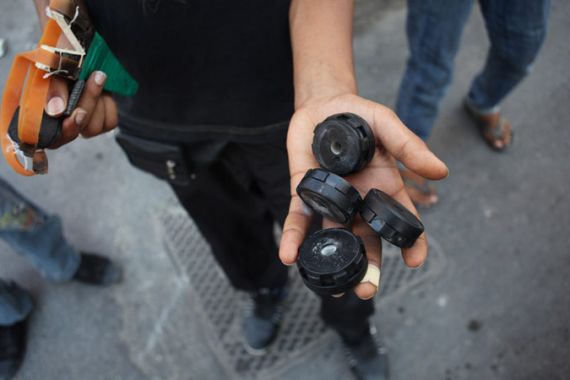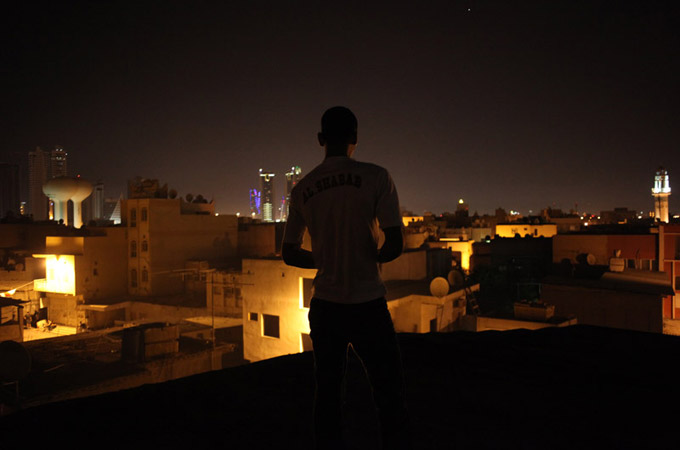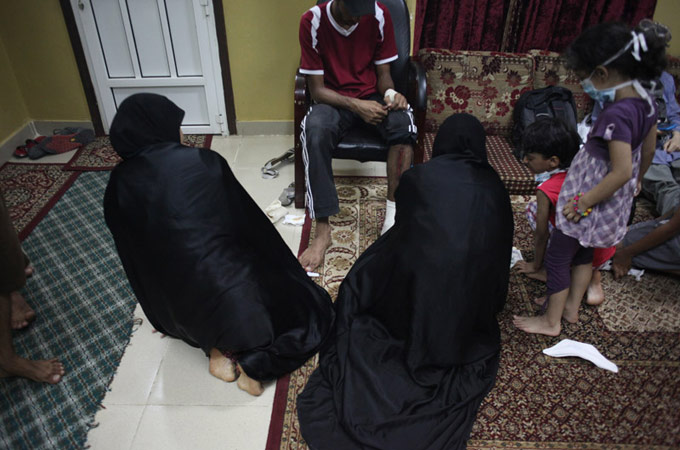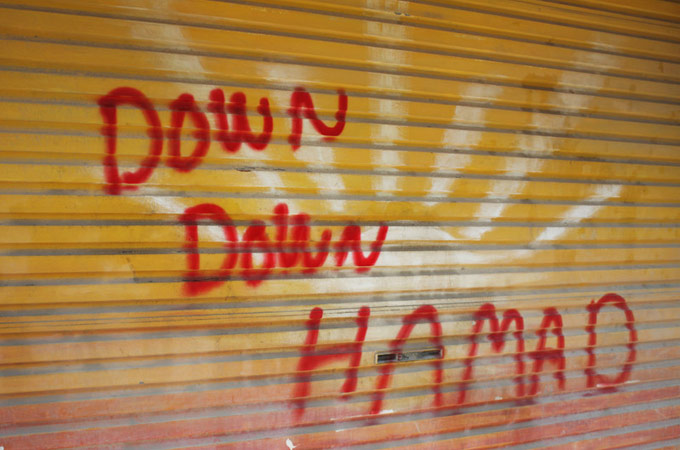48 hours in Sanabis
Protesters in Bahrain continue to struggle against government forces amid tear gas and an overwhelming police presence.

 |
| Activists are becoming more organised as the protests in Bahrain continue on a regular basis [Matthew Cassel] |
“We need supplies,” said the doctor, “Who can go get them?” One activist, a computer engineer in his 20s, quickly volunteered and invited me to go with him. It was nearly midnight and the injuries were piling into the makeshift medical clinic in a home in the Sanabis village, a suburb of Manama, the Bahraini capital. Injured protesters couldn’t be brought to hospitals or medical centres where they’d likely be arrested, so they were treated inside the villages. Volunteer medics were out of burn ointment and IV syringes, and needed someone to bring them from another makeshift clinic on the other side of the village.
There was a rare silence outside on the street. The protesters, mostly shabab (youth), had been dispersed only minutes earlier when dozens of police stormed through firing tear gas, rubber bullets and bird shot. The stench of gas still lingered; it never really disappeared fully from Sanabis during the two days of protests there.
We left the house into the streets. Some stone-carrying shabab were starting to return to the main crossings in central Sanabis, standing over broken glass and spent tear gas cartridges – all clearly marked “made in USA” – waiting for the police to return.
We passed through the narrow alleyways, some barely wide enough for a car to pass through. Some parts were well lit with the bright orange glow of the street lights, others pitch black. Some areas were tight giving a sense of protection, while others were more open, leaving us completely exposed for a number of seconds when anything could happen. We could only hope as we approached the next street corner that there wouldn’t be any police waiting around it, while we kept looking backwards to make sure there were none there either. Too fast and we would come upon them with no place to run, too slow and we’d get caught from behind.
In the chance that we did see police, which was more likely than not, we knew it’d already be too late. Their uniforms are unmistakable: blue bodysuits topped with bright white helmets. We had seen their weapons cause countless injuries all day long, and if we were spotted they’d fire at us. Up ahead atop a roof a couple of shabab on lookout waved to let us know the coast is clear. At the next crossing another group motioned for a signal to know if there are any white hats from where we just came.
As we continued to creep along in the shadows an abaya-clad woman peaked through the crack of her front door. “Come in,” she whispered waving her arms for us to get off the street, “do you need anything?” “Thank you, hajjiyyah, we are okay,” the runner whispered back, continuing his mission.
More than seven months after it began with marches of tens of thousands to Manama and sit-ins at the now-destroyed Pearl roundabout, this is what the Bahrain uprising has become.
After a brutal crackdown followed by months of martial law, the uprising is now largely confined to the numerous predominantly Shia villages around the country. It’s an increasingly organised and (still unarmed) guerilla resistance movement against the police force armed with “non-lethal weaponry”.
 |
| Treating the injured in a makeshift clinic [Matthew Cassel] |
The right of return
The protests last weekend were the biggest since martial law was lifted in early June. Two and a half months after they came, the Saudi and other troops from the Gulf Cooperation Council countries (the GCC includes Saudi Arabia, Bahrain, Oman, United Arab Emirates, Qatar and Kuwait) returned across the causeway, linking the small island nation to Saudi Arabia.
The two days of demonstrations were called for by the faceless February 14 youth coalition, named after the first day of the uprising, to coincide with a boycott of September 24 by-elections to replace 18 opposition members of parliament who resigned during the brutal government crackdown that killed more than 30 protesters earlier this year.
Posters for the candidates set to replace the MPs hung in Manama and a few other places around the country. However, in villages like Sanabis, their pictures were nowhere to be seen. “Traitors” and “opportunists” is what activists in Sanabis called them.
Shia Muslims, who make up a majority of the country’s population, say they’ve long faced discrimination by the ruling Sunni minority led by the al-Khalifa family. The government has accused the protesters of trying to create instability and being influenced by Iran.
The volunteer doctor in Sanabis disagreed that the conflict is sectarian, and said it’s a question of rights that can be found throughout the entire Gulf region. “All of the countries [in the Gulf],” he said, “are ruled by families who only know how to control people.”
A young activist in Sanabis told me that he’s boycotting the elections because none of the protesters’ grievances have been met, adding that the electoral process in Bahrain is “completely unfair”. He said that not only do Shia districts get a minority 18 out of the 40 electable seats in parliament because of government gerrymandering in the lead up to the 2002 elections, the first in almost 30 years, but the other 40 seats in parliament are selected the king.
“Basically, there is no parliament, only an image of one,” he said. “At the end of the day the king can do whatever he wants.”
The protests began on Friday, one day prior to the elections. The plan was to return to Pearl roundabout, some referred to it as “haq al-awda” (“the right of return”, taken from the Palestinian refugee struggle to return home) to return to the place they had made home before being forced out earlier this year. All day, activists sat waiting inside their homes for word from February 14 of when the protests would be called. Most homes had al-Alam on in the background, Iran’s Arabic-language satellite channel that planned a whole week of coverage on Bahrain. Al-Alam has become a default channel of the opposition for many activists who say state TV is incredibly biased and criticise the lack of coverage in other Arabic media.
I was led around parts of the village in the morning. Anti-government graffiti covered the once bare white walls of the villages homes and shops. “Down with [King] Hamad”, “self determination is our right”, “we will return [to Pearl roundabout]”. Garbage sat piled in corners and along the walls. Sanabis residents told me that as a form of collective punishment, the government ordered garbage collectors to halt service to a number of Shia villages. In Sanabis, some residents have organised their own garbage collection in response and carried their trash to main roads just outside their villages nearby to where police SUVs are stationed during protests.
Soon after lunch and the midday Friday prayers, the February 14 coalition announced the day’s plans. The group first posted the call on its Facebook page before it went viral on Twitter, BlackBerry Messenger, and other means of communication at the hands of the tech-savvy protesters. Sanabis, along with two other villages and Manama’s City Centre shopping mall, would be that day’s four points where protests would gather at 3:00 PM before heading (back) to Pearl roundabout.
 |
| Activists march in the street, chanting “yasqut Hamad” (down with Hamad) [Matthew Cassel] |
Cracking down
At 3:00 PM exactly, hundreds of shabab left their homes in Sanabis and descended into the streets. Chanting “yasqut Hamad” (down with Hamad). Most youth had their faces covered to not be identified and later arrested.
Police came from multiple positions on the outskirts of the village and immediately began firing tear-gas that sent the protesters fleeing in every direction. When they didn’t have anywhere to run and hide, protesters headed for the nearest door to any home so they could take cover inside. I sat with a group inside the walled garden of one home after being gassed in the street. We kept quiet as the police passed out front, knowing that if they suspected protesters were hiding inside they might throw gas over the wall or even invade the home. Video captured by Sanabis residents showed this happening multiple times throughout the day.
The “non-lethal” American-made tear-gas, which warns against firing it indoors or directly at protesters, has proven to be quite deadly in Bahrain over recent months.
A few weeks earlier, on August 31, at the end of the holy month of Ramadan, during an anti-government protest in Sitra, 14-year-old Ali al-Sheikh was hit with a tear gas canister in the head and killed. The picture of the boy’s bloodied corpse wearing an Italian football jersey that was circulated over the web outraged opposition supporters. Later that day the ministry of interior confirmed the death in a statement, however, it also read that “security forces had not dealt with any lawbreakers in Sitra” around the time of al-Sheikh’s death.
Rights groups have attributed at least six deaths to tear-gas – either from being hit by fired canisters, or inhalation of the gas – since protests recommenced after the lifting of martial law. On Friday, protesters said that the tear-gas, sound and flash grenades were responsible for at least three fires that were started inside Sanabis homes. In each case, no fire fighters entered the village, and residents were left trying to battle the blazes on their own.
As we hid in a home seeking shelter, a woman of the house told me: “Even when we watch them kill our children, we stay peaceful! That’s why the world cares about us.”
Until now, the essence of the uprising in Bahrain, like most other Arab uprisings, has been its peaceful nature. However, the continued crackdown against the unarmed protesters is creating anger, causing some opposition supporters to call for the means to better defend their communities.
Incidents like the one told to me by a sobbing 17-year-old woman is what is infuriating these Bahrainis. Sitting on a couch surrounded by two other young women comforting her and icing her swollen eye, she told me how she had been protesting when she fell behind a group of protesters fleeing tear-gas.
“I could tell he was Yemeni from his accent,” she said about the police officer who caught up to her.
Because Shia are almost all prevented from joining the state’s security services, including the police and army, the government hires Sunni Muslims from countries like Syria, Yemen, Pakistan and elsewhere to come to Bahrain and serve in its police force. Because the foreign fighters are naturalised citizens, opposition activists accuse the government of also using them to modify the country’s demographics.
The woman described what happened next: “[The officer] took me alone and started beating me on the abdomen. He shouted, ‘if by chance you’re pregnant I will beat you until you have an abortion.’ The rest of the police passed me laughing while I was on the ground. They were other Arabs, none of them were Bahraini.”
That evening, State TV ran pictures of men and women protesting at City Centre mall. The presenter called the protesters “savages”, and on the bottom of the screen the ministry of information asked for information that could lead to the the arrest of the protesters and an email address that people could write to.
Meanwhile, pictures were circulated on social media showing a number of female protesters who were arrested at the mall handcuffed and piled on top of each other.
When the doctor in the clinic broke from assisting a patient to check Twitter on his phone (as he did often) he was appalled. With his jaw dropped he grabbed me by the arm and pulled me aside. He showed me the image, which he compared with the infamous images of US soldiers abusing Iraqi detainees at Abu Ghraib, only these detainees were women and not men. “This kind of thing has never happened in the Islamic world,” he said, still staring at the image.
 |
| Graffiti denouncing the ruling elite of Bahrain has become commonplace [Matthew Cassel] |
Out of breath
On Saturday – election day – few went to cast their ballots while protests were called similar to Friday’s. Because its relative proximity to Pearl roundabout, the February 14 coalition again announced Sanabis as one of the meeting locations.
On the second day of protests, police seemed to employ a different tactic of dealing with demonstrators. Instead of starting outside the villages in big groups, they broke off into smaller groups to monitor almost every street in the village. And again, as soon as the protesters went out on the street, the tear-gas went flying. Before I saw a single protester, I knew from inside a home that the protest had started by the smell of tear-gas entering the house.
Despite the heavy police presence, hundreds of protesters still made their ways through the streets still chanting against the royal family.
Saturday night, protesters chanting “yasqut Hamad” and “Allahu akbar” (God is great) from the roofs of homes in an area of Sanabis. A few hundred meters away, across an empty plot of land, the silhouettes of dozens of police officers sat on a curb, seemingly exhausted from the long day. Ten blue and white police SUVs drove by on the road behind them with their blue lights flashing.
As the shouts continued, we peered over the roof’s ledge at the police to see them rise to their feet one by one and start walking towards the homes. The pops went off, and we heard the whizz of tear-gas canisters above our heads. Everyone on the roofs lay face down, twisting their necks to try and see where the canisters landed. “They’re firing on the roofs,” one protester whispers.
A few more pops, whizzes and then the sound of a metal can landing on the neighbour’s roof. In an instant, we all scurried on our stomachs and quickly dove back inside through the square opening that we had so carefully crawled out of earlier. “Shut it,” shouted one young man to another still trying to make his way inside.
It was already too late. The openings were all shut, but the gas was flowing in. A young man shoved us into his sister’s bedroom and quickly slammed the door and placed clothes at the bottom before checking that the windows were all completely sealed shut. One young man went to turn on the window air conditioning unit, “don’t do it!” another shouted. Eight of us sat on a plush pink bed in a sweltering hot room, listening to the sounds of tear-gas canisters land like raindrops on the roof above.
Through AC units, cracks in windows and doors, the tear-gas fired in the crowded areas entered many of the homes. In a neighbouring home where women and children from a few families gathered, the children all vomited when the tear-gas entered. The women, themselves suffocating from the gas, tried to comfort the children while finding a way to clear out the poisonous fumes. For more than 30 minutes the torturous gas lingered, unrelenting in its painful attack on everyone in the home. There was nowhere to run – if the gas wasn’t worse outside, than the police and their other weapons were.
When the gas stopped falling, a volunteer medic ran out to the street to grab an oxygen tank from her car that less than an hour earlier had it’s windows smashed by roaming police as they passed. All the cars lining the street met a similar fate. The medic, clutching a stone in her hand just in case, went off to check on the neighbours, especially the young and old, to make sure they’re okay. With no one on the outside to turn to, Sanabis was a community left to care for itself.
Moments later a couple of injured came into the home for treatment. The men said they were forced off the roof of a one story home by police and injured their arms and legs they hit the ground. Seeing the young men limping and holding their arms, one of the mothers in the room shouted:
“Stop listening to Nabeel Rajab and being peaceful. You have to defend yourselves!” The woman, like many opposition supporters, explained she had only the utmost respect and admiration for Rajab, a leading human rights advocate in Bahrain who since February has called on protesters to remain peaceful.
“That’s enough peacefulness, that’s it!” she continued. “They’ve gone too far when they violate women and children! Even in Islam when blood is spilt we have the right to self-defence.”
Return of the Safavids
In the early hours of the morning, when the clashes died down, protesters gathered in “safe homes”, said goodbye to each other and went their separate ways. I heard them jokingly refer to each other as “Safawiin” in Arabic and asked a protester what it meant.
He explained that he didn’t understand the term when he first heard the police and government supporters use it against them earlier this year, so he went online to find it’s meaning. He discovered it’s a reference to the 16th century Safavid dynasty in Iran, which first made Shia Islam the official state religion.
Rather than let the “ridiculous” name calling get to them, the protester laughingly explained how he and others appropriated the term and now use it amongst each other.
Like the Pearl monument, first built as a symbol of unity between Gulf nations, protesters appropriated the symbol as one of their revolution. After it was destroyed in March, half-dinar Bahraini coins bearing the monument’s image were taken out of circulation. Those coins are now a collector’s item, cherished by protesters nostalgic of the month they spent camped out at the roundabout, optimistic that change was on its way.
On Sunday morning (the beginning of the work week in Bahrain) after the protests, life went back to normal. Trash remained in the streets, and anti-government graffiti on the walls. Most spent tear-gas cartridges and rubber bullets had been collected by the protesters and brought home to add to their collections. Almost every house has one waiting to be shown off to the next foreign journalist who passes through.
Later that day, the government announced a 51 per cent election turnout. This was quickly discredited by analysts who crunched the government-provided election numbers by district to reach a 17 per cent total voter turnout. The boycott had been a success, opposition supporters showed that without real change from the government the ballot cannot deliver the change they’re fighting for.
Despite the frustration of not reaching their goal to return to Pearl monument, there wasn’t a sense of defeat among protesters after the two days of protests. “We get used to the tanks and the killing, it’s become routine,” said the computer engineer. “We are still out there calling for the end of al-Khalifa regime.”
Follow Matthew Cassel on Twitter: @justimage